Scary stories have been children’s literature favorites for generations of readers and their families. The language changes, but stories of tension, amazement, excitement and, at times, even humor remain ingredients for fright and horror. A collection of spooky stories and terrifying tales would not be complete without including a few favorites from the past that readers of any age return to for thrills and pleasure.
Ages 4–8
Fright Club. Ethan Long. 2015. Bloomsbury.
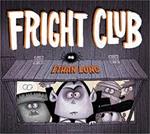 Vladimir has called one last meeting of the Fright Club to practice the three features of successful monsters before Operation Kiddie Scare. They are to practice ghoulish faces, scary moves, and chilling sounds. Already disappointed with the results of the members’ demonstrations of their fright skills, he answers a loud knock on the door and rejects the overtures of a bunny who wants to join the club. Even when the bunny returns with a lawyer, who challenges the exclusion, and a multitude of other cute critters, Vladimir stands firm and assures the members they will go away if ignored. When they become afraid of the critters who have taken up a vigil outside the clubhouse, the monsters invite them to demonstrate their frightening faces, moves, and sounds and accept them into the club. The new members cheer for the monsters’ skills. The book, with illustrations in dark, monotone colors, shows how the more the merrier holds true even for monsters.
Vladimir has called one last meeting of the Fright Club to practice the three features of successful monsters before Operation Kiddie Scare. They are to practice ghoulish faces, scary moves, and chilling sounds. Already disappointed with the results of the members’ demonstrations of their fright skills, he answers a loud knock on the door and rejects the overtures of a bunny who wants to join the club. Even when the bunny returns with a lawyer, who challenges the exclusion, and a multitude of other cute critters, Vladimir stands firm and assures the members they will go away if ignored. When they become afraid of the critters who have taken up a vigil outside the clubhouse, the monsters invite them to demonstrate their frightening faces, moves, and sounds and accept them into the club. The new members cheer for the monsters’ skills. The book, with illustrations in dark, monotone colors, shows how the more the merrier holds true even for monsters.
—SW
In a Dark, Dark Room and Other Scary Stories (An I Can Read! Book). Alvin Schwartz. Ill. Dirk Zimmer. 1985. HarperCollins.
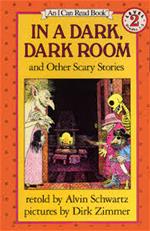 Variations on tales from different countries, including those in Europe and what is now Suriname in South America, the seven short stories in this anthology are scary but not too much. In one story, on a dark and stormy night, a man gives a boy a ride home and lends him his sweater to keep him warm. When the man returns to the house the next day to retrieve his sweater, the boy’s mother tells the man her son died one year ago. So the man goes to the cemetery, and there on the grave is his sweater. In “The Green Ribbon,” Jenny and Alfred grow up together, fall in love, and marry. Twice he asks her why she wears a green ribbon and she says she will tell him when the right time comes. On her deathbed he asks her a third time, and she tells him he can untie the ribbon to find out. He does and Jenny’s head falls off! The illustrations, done in warm and earthy hues, belie the ghostly and scary events of the stories.
Variations on tales from different countries, including those in Europe and what is now Suriname in South America, the seven short stories in this anthology are scary but not too much. In one story, on a dark and stormy night, a man gives a boy a ride home and lends him his sweater to keep him warm. When the man returns to the house the next day to retrieve his sweater, the boy’s mother tells the man her son died one year ago. So the man goes to the cemetery, and there on the grave is his sweater. In “The Green Ribbon,” Jenny and Alfred grow up together, fall in love, and marry. Twice he asks her why she wears a green ribbon and she says she will tell him when the right time comes. On her deathbed he asks her a third time, and she tells him he can untie the ribbon to find out. He does and Jenny’s head falls off! The illustrations, done in warm and earthy hues, belie the ghostly and scary events of the stories.
—SW
The Little Shop of Monsters. R.L. Stine; Ill. Marc Brown. 2015. Little, Brown.
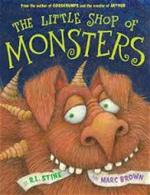 Those who can answer the unseen narrator’s question “Are you afraid of MONSTERS?” with a NO are invited to visit the Little Shop of Monsters. A boy and girl enter and view the caged monsters: Snacker, Stinky, Smelly, Sneezer, Bubble-Belly Billy, Yucky and Mucky, Squeezer and Teaser, Tina-Not-Ticklish, Sleeper-Peeper, and Piggler-Gigglers. Brown’s colorful portrait of each monster perfectly fits its characteristics and behavior. So many choices. Contrary to the process of selecting a pet, however, “[w]hen you come to the Little Shop of Monsters, you don’t CHOOSE a monster…A MONSTER CHOOSES YOU!” Following the narrator’s warning to turn the page fast, readers see the two children running off. Escape! The added invitation to come back again soon to perhaps find your monster (or will it find you?) serves as an invitation to read the book again.
Those who can answer the unseen narrator’s question “Are you afraid of MONSTERS?” with a NO are invited to visit the Little Shop of Monsters. A boy and girl enter and view the caged monsters: Snacker, Stinky, Smelly, Sneezer, Bubble-Belly Billy, Yucky and Mucky, Squeezer and Teaser, Tina-Not-Ticklish, Sleeper-Peeper, and Piggler-Gigglers. Brown’s colorful portrait of each monster perfectly fits its characteristics and behavior. So many choices. Contrary to the process of selecting a pet, however, “[w]hen you come to the Little Shop of Monsters, you don’t CHOOSE a monster…A MONSTER CHOOSES YOU!” Following the narrator’s warning to turn the page fast, readers see the two children running off. Escape! The added invitation to come back again soon to perhaps find your monster (or will it find you?) serves as an invitation to read the book again.
—CA
Scarecrow Magic. Ed Masessa. Ill. Matt Myers. 2015. Scholastic/Orchard.
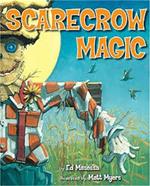 Written in rhyming language, the story recounts the activities of a man made of straw who, after dark and when the moon is full and bright, comes alive. The scarecrow takes off his clothes, revealing his skeleton self, and dives into the pond for a swim. In the field where the scarecrow stands and in the nearby woods, creatures come out to play and “[g]houlies and ghosties dance under the moon.” Gourds and pumpkins come alive in monster form and feast on delectable treats including fresh worms and snacks that have the odor of feet. The double-page illustrations in dark, rich colors of blues and purples have highlights reflecting the moonlight. When the sky grows light with the rising sun, the revelers depart. The skeleton scarecrow must put his uniform on again to stand on his post, knowing the party will come again.
Written in rhyming language, the story recounts the activities of a man made of straw who, after dark and when the moon is full and bright, comes alive. The scarecrow takes off his clothes, revealing his skeleton self, and dives into the pond for a swim. In the field where the scarecrow stands and in the nearby woods, creatures come out to play and “[g]houlies and ghosties dance under the moon.” Gourds and pumpkins come alive in monster form and feast on delectable treats including fresh worms and snacks that have the odor of feet. The double-page illustrations in dark, rich colors of blues and purples have highlights reflecting the moonlight. When the sky grows light with the rising sun, the revelers depart. The skeleton scarecrow must put his uniform on again to stand on his post, knowing the party will come again.
—SW
The Secret Room (The Haunted Library #5). Dori Hillestad Butler. Ill. Aurore Damant. 2015. Grosset & Dunlap.
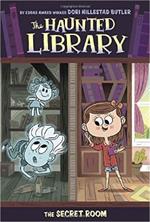 The ghostly good fun of this chapter book series with cartoon illustrations continues as ghost brothers Kaz and Little John, who live in an old mansion that houses the local library on the first floor, join fellow occupant ghost Beckett and Claire, a solid (the ghost term for a human) who lives on the second floor and can see and communicate with ghosts, in solving a mystery surrounding solid and ghostly objects found in a secret room. While they piece together the relationship between an envelope marked TOP SECRET, empty bottles, and a doll found in the room, Kaz and Little John are reunited with Grandmom and Grandpop, who are living in a new haunt, a nursing home, and Claire learns that her mother also had a ghost friend when she was young.
The ghostly good fun of this chapter book series with cartoon illustrations continues as ghost brothers Kaz and Little John, who live in an old mansion that houses the local library on the first floor, join fellow occupant ghost Beckett and Claire, a solid (the ghost term for a human) who lives on the second floor and can see and communicate with ghosts, in solving a mystery surrounding solid and ghostly objects found in a secret room. While they piece together the relationship between an envelope marked TOP SECRET, empty bottles, and a doll found in the room, Kaz and Little John are reunited with Grandmom and Grandpop, who are living in a new haunt, a nursing home, and Claire learns that her mother also had a ghost friend when she was young.
—CA
Tacky and the Haunted Igloo. Helen Lester. 2015. Ill. Lynn Munsinger. Houghton Mifflin Harcourt.
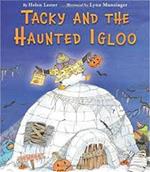 Goodly, Lovely, Angel, Neatly, and Perfect decorate their igloo and create costumes representing things they are afraid of such as insects, the dark, thunder and lightning, and bubbles. Tacky, lying about during the preparations, can think of nothing he is afraid of. When the other penguins prepare a rich array of treats, including batcicles and awful waffles, Tacky thoroughly samples them; but he must still find a costume, and sets out to find one. The double-page illustrations rendered in bright colors show the fast-paced action that occurs when a trio of hunters—a bear and two wolves, disguised as ghosts—arrive demanding treats. Tacky finally appears in his scary costume. Surprised by his costume, which looks exactly like the bear in his hunting cap and jacket, and terrified at the realization that Tacky is his twin, the bear leads the retreat from the igloo. The hunters flee in disarray without their ghostly disguises and the penguins greet Tacky in a way he doesn’t expect.
Goodly, Lovely, Angel, Neatly, and Perfect decorate their igloo and create costumes representing things they are afraid of such as insects, the dark, thunder and lightning, and bubbles. Tacky, lying about during the preparations, can think of nothing he is afraid of. When the other penguins prepare a rich array of treats, including batcicles and awful waffles, Tacky thoroughly samples them; but he must still find a costume, and sets out to find one. The double-page illustrations rendered in bright colors show the fast-paced action that occurs when a trio of hunters—a bear and two wolves, disguised as ghosts—arrive demanding treats. Tacky finally appears in his scary costume. Surprised by his costume, which looks exactly like the bear in his hunting cap and jacket, and terrified at the realization that Tacky is his twin, the bear leads the retreat from the igloo. The hunters flee in disarray without their ghostly disguises and the penguins greet Tacky in a way he doesn’t expect.
—SW
Ages 9–11
Fearsome Creatures of the Lumberwoods: 20 Chilling Tales From the Wilderness. Hal Johnson. Ill. Tom Mead. 2015. Workman.
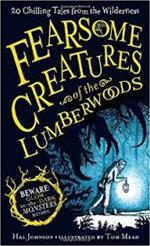 Johnson reimagines tales of creatures from American folklore found in William Cox’s Fearsome Creatures of the Lumberwoods (1910), with an unnamed narrator, an imminent cryptozoologist who has knowledge of these deadly beasts based on personal encounters. The narrator offers gruesome details of the characteristics and behavior of fearsome creatures of the wild, untamed lumberwoods of North America and reports the tragic fates of both amateurs and experts who have sought to capture them. The chilling stories of the hodag, slide-rock bolter, cactus cat, whirling whimpus, hoop snake, and 15 other strange beasts are peppered with humorous, nervous giggle-inducing comments. Mead’s black-and-white cartoons, including some glow-in-the dark portraits of the creatures, perfectly mirror the creepiness of the tales. The appendix includes a “Fearsome Facts” chart listing the habitat, range, size, diet, life span, speed, and rankings on fearsomeness and absurdity of each creature.
Johnson reimagines tales of creatures from American folklore found in William Cox’s Fearsome Creatures of the Lumberwoods (1910), with an unnamed narrator, an imminent cryptozoologist who has knowledge of these deadly beasts based on personal encounters. The narrator offers gruesome details of the characteristics and behavior of fearsome creatures of the wild, untamed lumberwoods of North America and reports the tragic fates of both amateurs and experts who have sought to capture them. The chilling stories of the hodag, slide-rock bolter, cactus cat, whirling whimpus, hoop snake, and 15 other strange beasts are peppered with humorous, nervous giggle-inducing comments. Mead’s black-and-white cartoons, including some glow-in-the dark portraits of the creatures, perfectly mirror the creepiness of the tales. The appendix includes a “Fearsome Facts” chart listing the habitat, range, size, diet, life span, speed, and rankings on fearsomeness and absurdity of each creature.
—CA
The Halloween Tree. Ray Bradbury. Ill. Gris Grimly. 2015. Alfred A. Knopf.
 Tom Skelton puts on his costume of bones, musing about the connection between his name and the costume as he prepares for an evening of fun with his group of friends on Halloween. When Pipkin appears, not in costume but with pain in his side, however, the evening takes a turn none of them could have imagined. Pipkin instructs them to go to a particular house. The boys arrive at this house, its door knocker comes alive, a wind attempts to pull them into its dark reaches, and a spirit emerges out of the Halloween tree to take them on a journey. He guides them through a history of Halloween and the homage to the dead by the Egyptians, Romans, Druids, the people of the Middle Ages in England and France, and the people of Mexico, that is as dramatic in its progress as it is breathtaking before he tells them they need to make a sacrifice for their friend. Grimly’s nightmarish black-and-white drawings and three full-color plates in autumnal hues for Bradbury’s Halloween tale, originally published in 1972, depict the setting and stages of the nocturnal journey of the boys.
Tom Skelton puts on his costume of bones, musing about the connection between his name and the costume as he prepares for an evening of fun with his group of friends on Halloween. When Pipkin appears, not in costume but with pain in his side, however, the evening takes a turn none of them could have imagined. Pipkin instructs them to go to a particular house. The boys arrive at this house, its door knocker comes alive, a wind attempts to pull them into its dark reaches, and a spirit emerges out of the Halloween tree to take them on a journey. He guides them through a history of Halloween and the homage to the dead by the Egyptians, Romans, Druids, the people of the Middle Ages in England and France, and the people of Mexico, that is as dramatic in its progress as it is breathtaking before he tells them they need to make a sacrifice for their friend. Grimly’s nightmarish black-and-white drawings and three full-color plates in autumnal hues for Bradbury’s Halloween tale, originally published in 1972, depict the setting and stages of the nocturnal journey of the boys.
—SW
The Jumbies. Tracy Baptiste. 2015. Algonquin Young Readers.
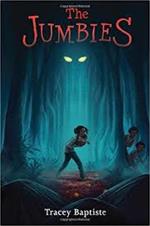 Baptiste notes that the book is inspired by a Haitian folktale about a magic orange tree and conflates it with the jumbie of Trinidad—a bad-thinking, sneaky, selfish, greedy creature whose purpose is causing trouble—that inhabits forests but can emerge and enter homes and communities. In this novel, Corinne lives with her fisherman father, Pierre, and harvests the most exquisite oranges on the island to share with friends and sell. One jumbie, Severin, has designs on the community and Pierre, and steals magic potions from the local witch. Severin ingratiates herself into Pierre’s life; her powers of magic bewitch him but do not fool Corinne. She aims to reclaim the island that had belonged to the jumbies centuries before Europeans arrived and to claim a family of her own. Readers learn that Corinne’s mother was Severin’s sister, Nicole, a woman of generous spirit. Corinne must discover her own kind of magic if she is to save her father and protect her friends, who all help save the community from the jumbies.
Baptiste notes that the book is inspired by a Haitian folktale about a magic orange tree and conflates it with the jumbie of Trinidad—a bad-thinking, sneaky, selfish, greedy creature whose purpose is causing trouble—that inhabits forests but can emerge and enter homes and communities. In this novel, Corinne lives with her fisherman father, Pierre, and harvests the most exquisite oranges on the island to share with friends and sell. One jumbie, Severin, has designs on the community and Pierre, and steals magic potions from the local witch. Severin ingratiates herself into Pierre’s life; her powers of magic bewitch him but do not fool Corinne. She aims to reclaim the island that had belonged to the jumbies centuries before Europeans arrived and to claim a family of her own. Readers learn that Corinne’s mother was Severin’s sister, Nicole, a woman of generous spirit. Corinne must discover her own kind of magic if she is to save her father and protect her friends, who all help save the community from the jumbies.
—SW
Scary Stories to Tell in the Dark. Alvin Schwartz. Ill. Stephen Gammell. 1981. HarperCollins.
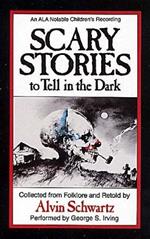 Folklorist Schwartz organizes his retellings of 29 scary folktales in five sections: jump stories (with directions to the storyteller about making exclamations at crucial moments to elicit physical reactions from listeners); ghost stories; scary stories about all kinds of things such as hearses, graves, and spirits; belief legends that serve as cautionary tales about dangers that might be met in day-to-day life; and stories meant to make you laugh more than to scare you. And if the stories alone don’t scare you, Gammell’s creepy drawings will. Back matter includes notes on the tales, sources, and a bibliography. Schwartz’s series of scary American folklore continues in More Scary Stories to Tell in the Dark (1984) and Scary Stories 3: More Tales to Chill Your Bones (1991).
Folklorist Schwartz organizes his retellings of 29 scary folktales in five sections: jump stories (with directions to the storyteller about making exclamations at crucial moments to elicit physical reactions from listeners); ghost stories; scary stories about all kinds of things such as hearses, graves, and spirits; belief legends that serve as cautionary tales about dangers that might be met in day-to-day life; and stories meant to make you laugh more than to scare you. And if the stories alone don’t scare you, Gammell’s creepy drawings will. Back matter includes notes on the tales, sources, and a bibliography. Schwartz’s series of scary American folklore continues in More Scary Stories to Tell in the Dark (1984) and Scary Stories 3: More Tales to Chill Your Bones (1991).
—CA
Trick or Trap (Goosebumps Most Wanted Special Edition #3). R.L. Stine. 2015. Scholastic.
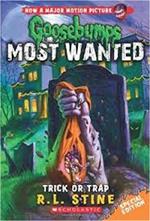 Best friends Scotty Harmon and Amanda Gold readily admit to being cowardly, wimpy, and scared of just about everything. Scotty’s younger sister, Rita, delights in scaring Scotty and watching him scream his head off. And then there are the Klass twins, Mickey and Morty, and their sidekick Kenji, who delight in terrifying Scotty and Amanda. With the approach of Halloween, Scotty and Amanda plan to toughen up and get revenge against their tormentors. They decide to host a scary party in the old, abandoned house that everyone says is haunted. On Halloween night, however, the house plays its own tricks and sets its own traps. Terrified, all escape from the house unscathed—or do they? As Stine’s fans have come to expect, he ends this spooky Goosebumps book with a surprise.
Best friends Scotty Harmon and Amanda Gold readily admit to being cowardly, wimpy, and scared of just about everything. Scotty’s younger sister, Rita, delights in scaring Scotty and watching him scream his head off. And then there are the Klass twins, Mickey and Morty, and their sidekick Kenji, who delight in terrifying Scotty and Amanda. With the approach of Halloween, Scotty and Amanda plan to toughen up and get revenge against their tormentors. They decide to host a scary party in the old, abandoned house that everyone says is haunted. On Halloween night, however, the house plays its own tricks and sets its own traps. Terrified, all escape from the house unscathed—or do they? As Stine’s fans have come to expect, he ends this spooky Goosebumps book with a surprise.
—CA
Ages 12–14
Guys Read: Terrifying Tales (Guys Read Series #6). Jon Scieszka (Ed.). Ill. Gris Grimly. 2015. Walden Pond/HarperCollins.
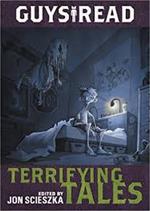 In the introduction, Jon Scieszka says the writers were told “to go all out to shake you up, freak you out, and just completely terrify you” (p. 4). Just the titles of the stories alone such as Adam Gidwitz’s “The Blue-Bearded Bird-Man,” Kelly Barnhill’s “Don’t Eat the Baby,” and R.L. Stine’s “Disappear!” and Gris Grimly’s creepy full-page illustrations that introduce the stories are disturbing. Those who go on to read the 10 well-crafted terrifying tales will agree the writers do a great job of both scaring and surprising readers. Good short stories such as those in this Guys Read book encourage young readers to seek more stories by the writers of their favorites. The appended biographical sketches of the authors include a listing of selected titles that will serve guys—and gals—as a good source of more good reading.
In the introduction, Jon Scieszka says the writers were told “to go all out to shake you up, freak you out, and just completely terrify you” (p. 4). Just the titles of the stories alone such as Adam Gidwitz’s “The Blue-Bearded Bird-Man,” Kelly Barnhill’s “Don’t Eat the Baby,” and R.L. Stine’s “Disappear!” and Gris Grimly’s creepy full-page illustrations that introduce the stories are disturbing. Those who go on to read the 10 well-crafted terrifying tales will agree the writers do a great job of both scaring and surprising readers. Good short stories such as those in this Guys Read book encourage young readers to seek more stories by the writers of their favorites. The appended biographical sketches of the authors include a listing of selected titles that will serve guys—and gals—as a good source of more good reading.
—CA
The Legend of Sleepy Hollow. Washington Irving. Ill. Arthur Rackham. 1990. William Morrow/Books of Wonder.
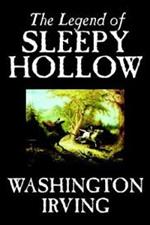 In this reissue of the 1928 edition of the story, complete with the original set of Rackham’s full-color paintings and pen-and-ink drawings, the language of Irving’s story of 1815 is fresh and exciting as readers meet the dignified and polite Ichabod Crane, who is the teacher in a town in the valleys, or hollows, of New York, inhabited by Dutch farmers and their families. The story is as much a romance with Ichabod, smitten by the lovely, bewitching, and wealthy Katrina, as it is a chronicle of the man who saw himself an honorable knight errant and a willing adversary to the muscular, boisterous Brom Bones, who also sought Katrina’s hand and affections. The descriptions of the towns, the people, and Ichabod’s scholarship are humorous and heartful, yet the story turns ominous when all the town’s folk are invited to a lavish party during which Katrina rebuffs Ichabod. Ichabod’s boney horse takes a turn through Sleepy Hollow and he becomes the stuff of legend.
In this reissue of the 1928 edition of the story, complete with the original set of Rackham’s full-color paintings and pen-and-ink drawings, the language of Irving’s story of 1815 is fresh and exciting as readers meet the dignified and polite Ichabod Crane, who is the teacher in a town in the valleys, or hollows, of New York, inhabited by Dutch farmers and their families. The story is as much a romance with Ichabod, smitten by the lovely, bewitching, and wealthy Katrina, as it is a chronicle of the man who saw himself an honorable knight errant and a willing adversary to the muscular, boisterous Brom Bones, who also sought Katrina’s hand and affections. The descriptions of the towns, the people, and Ichabod’s scholarship are humorous and heartful, yet the story turns ominous when all the town’s folk are invited to a lavish party during which Katrina rebuffs Ichabod. Ichabod’s boney horse takes a turn through Sleepy Hollow and he becomes the stuff of legend.
—SW
The Nest. Kenneth Oppel. Ill. Jon Klassen. 2015. Simon & Schuster.
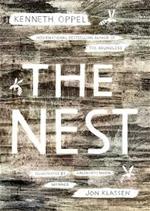 Steve is allergic to wasps; he worries about his baby brother, Theo, who has a congenital problem and a poor prognosis for survival; he has anxieties and fears for which he has seen a psychiatrist; and he has vivid dreams. In one nightmare, a wasp of pale color appears to him saying she and her colony can help with the baby. As the dreams become more frequent, Steve tells the wasp the baby needs an operation and asks her when she is going to make the baby better as she promised. “My dear boy, we’re working on it right now” (p. 67), she says. He pressures his father to remove the wasp’s nest outside the baby’s window until he learns the wasps are nurturing a baby there. When the queen sets a deadline for putting the new baby into the crib, the gut-wrenching novel grows increasingly ominous until dream intersects with reality and a showdown with swarms of wasps infiltrating the house challenges Steve’s resourcefulness. The dark, shadowy illustrations convey the menacing and dreamlike bind that Steve finds himself in.
Steve is allergic to wasps; he worries about his baby brother, Theo, who has a congenital problem and a poor prognosis for survival; he has anxieties and fears for which he has seen a psychiatrist; and he has vivid dreams. In one nightmare, a wasp of pale color appears to him saying she and her colony can help with the baby. As the dreams become more frequent, Steve tells the wasp the baby needs an operation and asks her when she is going to make the baby better as she promised. “My dear boy, we’re working on it right now” (p. 67), she says. He pressures his father to remove the wasp’s nest outside the baby’s window until he learns the wasps are nurturing a baby there. When the queen sets a deadline for putting the new baby into the crib, the gut-wrenching novel grows increasingly ominous until dream intersects with reality and a showdown with swarms of wasps infiltrating the house challenges Steve’s resourcefulness. The dark, shadowy illustrations convey the menacing and dreamlike bind that Steve finds himself in.
—SW
Took: A Ghost Story. Mary Downing Hahn. 2015. Clarion.
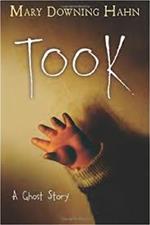 The recession of 2008 has created setbacks for Daniel, Erica, and their parents, precipitating their decision to move into an old house surrounded by woods outside a town in West Virginia. Known as the Estes house, it comes with the tale that Selene, a child who had lived there 50 years before they moved in, “got took.” Daniel and Erica are miserable; he is bullied at school, and her conversations with her doll, Little Erica, increase in number and length. Readers are introduced to another story, the tale of Old Auntie and her pet hog, Bloody Bones, narrated by an old woman. While Daniel is watchful of the woods and swears he observes shadowy figures, Erica hears her name whispered in the rustling leaves of the woods. When she is enticed to the woods by the haunting sound, Daniel chases after and brings her back. With her doll left in the woods, Erica is inconsolable. And so begins a series of events, tense with uncertain outcomes with Erica’s disappearance, the family’s despair, Daniel’s sense of guilt and failure, and a possible solution to a mystery that is generations old.
The recession of 2008 has created setbacks for Daniel, Erica, and their parents, precipitating their decision to move into an old house surrounded by woods outside a town in West Virginia. Known as the Estes house, it comes with the tale that Selene, a child who had lived there 50 years before they moved in, “got took.” Daniel and Erica are miserable; he is bullied at school, and her conversations with her doll, Little Erica, increase in number and length. Readers are introduced to another story, the tale of Old Auntie and her pet hog, Bloody Bones, narrated by an old woman. While Daniel is watchful of the woods and swears he observes shadowy figures, Erica hears her name whispered in the rustling leaves of the woods. When she is enticed to the woods by the haunting sound, Daniel chases after and brings her back. With her doll left in the woods, Erica is inconsolable. And so begins a series of events, tense with uncertain outcomes with Erica’s disappearance, the family’s despair, Daniel’s sense of guilt and failure, and a possible solution to a mystery that is generations old.
—SW
The Wicked Cat (Spooksville #10). Christopher Pike. 2015. Aladdin.
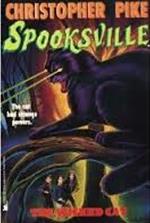 While exploring in the woods outside Spooksville, pals Adam, Watch, Sally, and Cindy find a green-eyed black cat that follows them back to town. Although the cat attacks and scratches Cindy badly, Sally takes it home. Wherever the cat is, however, strange things happen, including a fire on Cindy’s front porch when she won’t let the cat in the house. When the cat speaks to Sally, saying she too can have magic powers if she repeats “I want to be a cat. Sally wants to be a cat,” things really get weird. Sally’s friends, with the help of the town witch, Ann Templeton, and homeless Bum, the ex-mayor who knows all about the history of Spooksville, must discover how to undo the trading of places of the cat and Sally before things turn deadly. Aladdin is reissuing all of Pike’s Spooksville horror stories, originally published from 1995 to 1998.
While exploring in the woods outside Spooksville, pals Adam, Watch, Sally, and Cindy find a green-eyed black cat that follows them back to town. Although the cat attacks and scratches Cindy badly, Sally takes it home. Wherever the cat is, however, strange things happen, including a fire on Cindy’s front porch when she won’t let the cat in the house. When the cat speaks to Sally, saying she too can have magic powers if she repeats “I want to be a cat. Sally wants to be a cat,” things really get weird. Sally’s friends, with the help of the town witch, Ann Templeton, and homeless Bum, the ex-mayor who knows all about the history of Spooksville, must discover how to undo the trading of places of the cat and Sally before things turn deadly. Aladdin is reissuing all of Pike’s Spooksville horror stories, originally published from 1995 to 1998.
—CA
Ages 15+
Don’t Stay Up Late: A Fear Street Novel. R.L. Stine. 2015. Thomas Dunne Books/St. Martin’s Press.
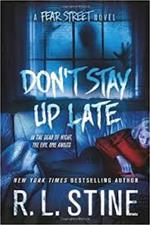 Lisa Brooks has been left with nightmares and hallucinations after a car accident that killed her father and injured her mother. Nonetheless, when her therapist recommends Lisa for a babysitting job on Shadyside’s Fear Street, she takes it in spite of the superstition that those who live on the street are cursed. Caring for Harry, an apparently lovable young boy, comes with one strict guideline: Under no circumstance can he stay up late. Lisa loves her new job, but Harry is a manipulative charmer and getting him to bed by eight o’clock becomes increasingly more difficult. Then the monstrous killings of two of Lisa’s school friends occur on Fear Street and Lisa begins to see things—things her therapist says she shouldn’t be seeing, whether they are real or not. With this second entry in the relaunch of Stine’s popular series, fans can rest assured that evil still resides on Fear Street.
Lisa Brooks has been left with nightmares and hallucinations after a car accident that killed her father and injured her mother. Nonetheless, when her therapist recommends Lisa for a babysitting job on Shadyside’s Fear Street, she takes it in spite of the superstition that those who live on the street are cursed. Caring for Harry, an apparently lovable young boy, comes with one strict guideline: Under no circumstance can he stay up late. Lisa loves her new job, but Harry is a manipulative charmer and getting him to bed by eight o’clock becomes increasingly more difficult. Then the monstrous killings of two of Lisa’s school friends occur on Fear Street and Lisa begins to see things—things her therapist says she shouldn’t be seeing, whether they are real or not. With this second entry in the relaunch of Stine’s popular series, fans can rest assured that evil still resides on Fear Street.
—CA
The House. Christina Lauren. 2015. Simon & Schuster.
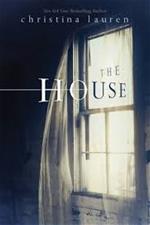 In this horror novel, Christina Hobbs and Lauren Billlings (writing under the pen name Christina Lauren) put a twist on the haunted house subgenre. Gavin lives alone in a very strange house. The house and all the objects in it are alive. House has loved Gavin and provided for all his needs from early childhood. Now as his relationship with Delilah, who has been away for years at a private school, turns romantic, Gavin tells her of his strange living arrangement, brings her home, and introduces her to House as someone important in his life. Possessive House doesn’t like it at all. As Gavin becomes increasingly more insistent that House accept Delilah and the teens talk about going away to college, House becomes cold and violent, seriously injuring Delilah and punishing Gavin. When the intention of House to do anything to keep them apart becomes apparent, they set about planning for escape. House will not make it easy.
In this horror novel, Christina Hobbs and Lauren Billlings (writing under the pen name Christina Lauren) put a twist on the haunted house subgenre. Gavin lives alone in a very strange house. The house and all the objects in it are alive. House has loved Gavin and provided for all his needs from early childhood. Now as his relationship with Delilah, who has been away for years at a private school, turns romantic, Gavin tells her of his strange living arrangement, brings her home, and introduces her to House as someone important in his life. Possessive House doesn’t like it at all. As Gavin becomes increasingly more insistent that House accept Delilah and the teens talk about going away to college, House becomes cold and violent, seriously injuring Delilah and punishing Gavin. When the intention of House to do anything to keep them apart becomes apparent, they set about planning for escape. House will not make it easy.
—CA
In the Shadow of Edgar Allan Poe: Classic Tales of Horror, 1816–1914. Leslie S. Klinger (Ed.). 2015. Perseus Crime.
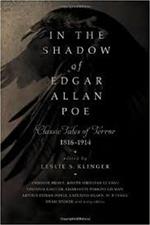 Klinger has compiled a selection of horror tales by 19th-century writers whose short stories have mostly been lost “in the Shadow of Edgar Allan Poe.” The 20 tales are organized in chronological order, and each is introduced with a brief biographical note on the author’s literary contributions. Some of the authors are well known but are not remembered primarily for their short stories. For example, the first tale, “The Sand-Man” (1817), is by E.T.A. Hoffmann, who is best known for his novel The Nutcracker and the Mouse King (1916), which became the basis of Tchaikovsky’s The Nutcracker ballet. The final short story, “The Squaw” (1893), was written by Bram Stoker. Stoker wrote numerous short stories, but his novel Dracula (1897)is his tale of horror that is widely read today. Writing styles, vocabulary, and obscure references (which are explained in footnotes) make this a challenging collection to read. Those who accept the challenge will be treated to hours of masterful horror writing by 19th-century authors whose influences are acknowledged by some of the foremost writers of fantasy today.
Klinger has compiled a selection of horror tales by 19th-century writers whose short stories have mostly been lost “in the Shadow of Edgar Allan Poe.” The 20 tales are organized in chronological order, and each is introduced with a brief biographical note on the author’s literary contributions. Some of the authors are well known but are not remembered primarily for their short stories. For example, the first tale, “The Sand-Man” (1817), is by E.T.A. Hoffmann, who is best known for his novel The Nutcracker and the Mouse King (1916), which became the basis of Tchaikovsky’s The Nutcracker ballet. The final short story, “The Squaw” (1893), was written by Bram Stoker. Stoker wrote numerous short stories, but his novel Dracula (1897)is his tale of horror that is widely read today. Writing styles, vocabulary, and obscure references (which are explained in footnotes) make this a challenging collection to read. Those who accept the challenge will be treated to hours of masterful horror writing by 19th-century authors whose influences are acknowledged by some of the foremost writers of fantasy today.
—CA
Sandip Wilson serves as associate professor in the School of Education and in the English Department of Husson University, Bangor, ME. Carolyn Angus is former director of the George G. Stone Center for Children’s Books, Claremont Graduate University, and lives in Mountain View, CA.
The review contributions are provided by members of the International Literacy Association’s Children’s Literature and Reading Special Interest Group.